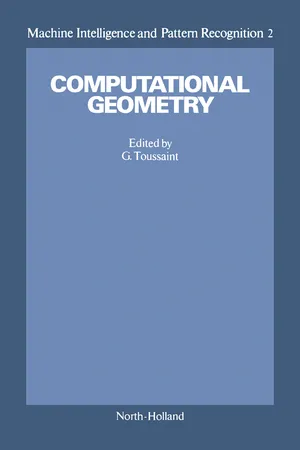
- 472 pages
- English
- PDF
- Only available on web
Machine Intelligence and Pattern Recognition
About This Book
Machine Intelligence and Pattern Recognition, Volume 2: Computational Geometry focuses on the operations, processes, methodologies, and approaches involved in computational geometry, including algorithms, polygons, convex hulls, and bucketing techniques. The selection first ponders on optimal parallel algorithms for selection, sorting, and computing convex hulls, simple on-line algorithms for convex polygons, and geometric algorithms that use the furthest-point Voronoi diagram. Discussions focus on algorithms that use the furthest-point Voronoi diagram, intersection of a convex polygon and a halfplane, point insertion, convex hulls and polygons and their representations, and parallel algorithm for selection and computing convex hulls. The text then examines optimal convex decompositions, expected time analysis of algorithms in computational geometry, and practical use of bucketing techniques in computational geometry. The book takes a look at minimum decompositions of polygonal objects, framework for computational morphology, display of visible edges of a set of convex polygons, and implementation study of two algorithms for the minimum spanning circle problem. Topics include rolling algorithm, shape of point sets, and decomposition of rectilinear and simple polygons and polygons with holes. The selection is a valuable source of data for researchers interested in computational geometry.
Frequently asked questions
Information
Table of contents
- Front Cover
- Computational Geometry
- Copyright Page
- Table of Contents
- Dedication
- PREFACE
- CHAPTER 1. OPTIMAL PARALLEL ALGORITHMS FOR SELECTION, SORTING AND COMPUTING CONVEX HULLS
- CHAPTER 2. SIMPLE ON-LINE ALGORITHMS FOR CONVEX POLYGONS
- CHAPTER 3. ON GEOMETRIC ALGORITHMS THAT USE THE FURTHEST-POINT VORONOI DIAGRAM
- CHAPTER 4. OPTIMAL CONVEX DECOMPOSITIONS
- CHAPTER 5. EXPECTED TIME ANALYSIS OF ALGORITHMS IN COMPUTATIONAL GEOMETRY
- Chapter 6. Practical Use of Bucketing Techniques in Computational Geometry
- Chapter 7. Minimum Decompositions of Polygonal Objects
- CHAPTER 8. A FRAMEWORK FOR COMPUTATIONAL MORPHOLOGY
- CHAPTER 9. DISPLAY OF VISIBLE EDGES OF A SET OF CONVEX POLYGONS
- CHAPTER 10. AN IMPLEMENTATION STUDY OF TWO ALGORITHMS FOR THE MINIMUM SPANNING CIRCLE PROBLEM
- Chapter 11. Curve Similarity via Signatures
- CHAPTER 12. A METHOD FOR PROVING LOWER BOUNDS FOR CERTAIN GEOMETRIC PROBLEMS
- CHAPTER 13. MOVABLE SEPARABILITY OF SETS
- Chapter 14. Computational Geometry and Motion Planning
- CHAPTER 15. AN ISOTHETIC VIEW OF COMPUTATIONAL GEOMETRY